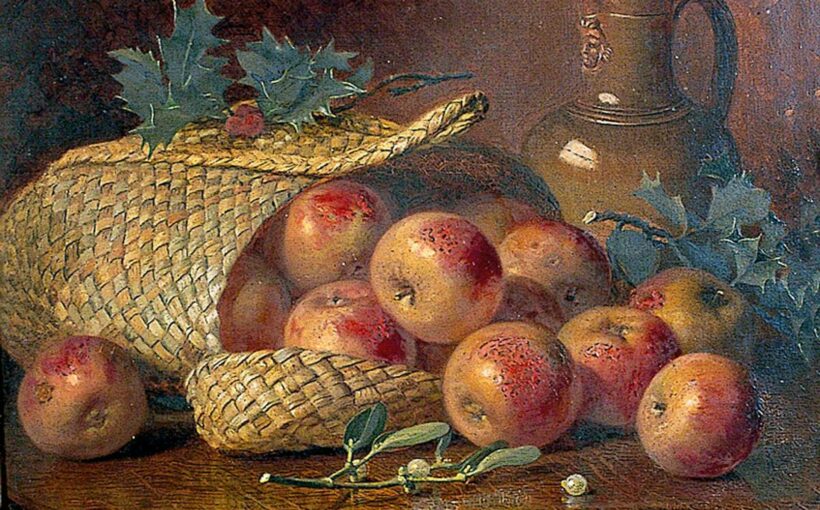Reading labels in the supermarket, you may have wondered where your apples come from – but have you ever thought about why you’re eating apples in the first place? Author Sally Coulthard’s new book gives you the answer to this question – and to many more you’d never thought to ask.
From the birthplace of the apple in the Tian Sian mountains of Kazakhstan to the modern mass-production of popular varieties like Pink Ladies, Coulthard gives a step-by-step account of how apples became one of the best-known fruits in the world.
Apples might seem a typically British fruit but, like rhubarb or commercial strawberries, the apples we eat today are not native to Britain. They are actually the result of global trade and migration going back thousands of years.
The earliest apples in Britain were the wild crab variety, which are too small and sour to bring much pleasure – although they were later used for making cider and verjuice (a highly acidic juice). We have the Romans, Normans and medieval monks to thank for our sweet apples. They carefully brought over cuttings and saplings of their favourite fruit, and from there they spread across the globe.
If there’s one thing that defines the history of the apple, it’s variety. Ever heard of an Early Julien, or maybe a Teuchat’s Egg? How about a Flushing Spitzenburgh? By the late 19th century, nearly 1,500 varieties were recognised in Britain alone. Throughout history, gardeners went mad for finding and creating different kinds, crossbreeding hundreds of new apples across the world.
Unfortunately, if you want to try a Bedfordshire Foundling or a Catshead today, you’re out of luck. Through steady commercialisation, most of these varieties have been lost to history, and today’s consumers have at best seven types to choose from in British shops.
A loss of biodiversity
In 1618, gardener William Lawson wrote about an apple tree “which I have knowne these forty yeeres, whose age before my time I cannot learne, it is beyond memory, tho I have enquired of divers aged men of 80 yeeres and upwards”. Lawson’s story would be familiar to most people in his time, for whom centuries-old apple trees were a normal sight.
For us, the landscape is very different. The hardest part of Coulthard’s history to swallow is the loss of diversity over the past hundred years. A shocking 80% of traditional orchards have been destroyed in this time, which a recent National Trust study has described as an equivalent landmass to Isle of Wight.
While the Trust has promised to plant 4 million blossoming trees by 2030 to provide food for pollinating insects, the fate of British apples very much hangs in the balance.

Coulthard shows that our orchards are actually a casualty of post-world war attempts at increasing food security; with old trees making way for vegetable and grain crops. Ironically, it’s meant that today less that 40% of the apples bought in the UK are produced here, which is costing the environment through transport emissions.
The recent election brought promises of increased food security from all parties, although it remains to be seen how this will play out.
Still, The Apple reminds us that nothing is new under the sun, as four-time prime minister William Gladstone (1809-98) once pleaded with British farmers to grow more apples when faced with the same issue of foreign apple imports overtaking in the market. There was even a Gladstone apple named after him – maybe there’ll be a Starmer next?
If we do return to British-only apple production, we might also regain some of the seasonal food habits and traditions which made apples special in the first place. The apple tree only produces fruit from early autumn to winter in the northern hemisphere, which is why so many of our winter traditions centre around apples. Some of these we still have, like apple-bobbing around Halloween, while others are mostly forgotten, like the traditional “lambswool” drink of ale mixed with roasted apples.
Even to me, a historian of tomatoes (coincidentally first called “love apples” in English) the idea of a 300-page book on just apples seemed a little daunting. Thankfully, Coulthard’s lively and engaging style makes it a real treat, and an easy read for any history lover.
Even if you know nothing about British history, The Apple makes sure to provide plenty of context for each twist and turn. And as each chapter ends with a deeper history of 12 apple recipes – from homely apple pie to powerful applejack liquor – it leaves you with plenty of food for thought.

Looking for something good? Cut through the noise with a carefully curated selection of the latest releases, live events and exhibitions, straight to your inbox every fortnight, on Fridays. Sign up here.
![]()
Serin Quinn does not work for, consult, own shares in or receive funding from any company or organisation that would benefit from this article, and has disclosed no relevant affiliations beyond their academic appointment.



